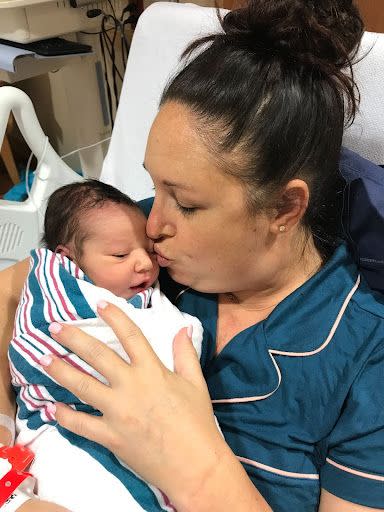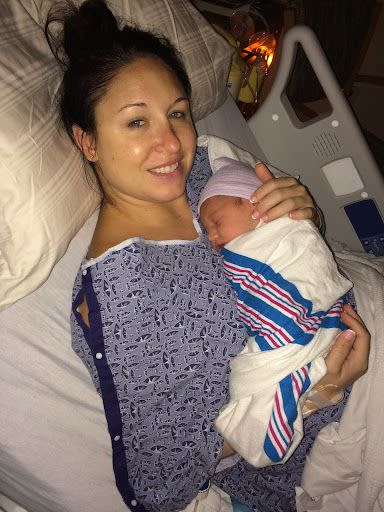‘I Had Severe Pelvic Pain After Giving Birth—Here’s What Doctors Missed’

When it comes to birth experiences, things never really go exactly the way you plan. I had an uncomfortable pregnancy with my first child, all the way through. Prolonged labor, approximately 20 hours or more with a first child, can increase risk of infection, and doctors often perform an emergency C-section at that point as a precaution. Toward the end of my first pregnancy, I asked my doctor to induce me into labor so I could give birth vaginally. The doctor induced me, but the labor did not progress quickly enough.
My options by that point were to either: have a C-section about 20 hours into labor or try to stay in labor for another five hours and have an emergency C-section, which could be more stressful. I really did not want to have a C-section, but I figured it was best for the safety of my child and myself, so that’s what I did. My first child, Dylan, was born by C-section in December 2013.
Recovery from the C-section was a challenge. While my first baby was fine after the C-section delivery, I was not—from a physical or mental health perspective—during postpartum recovery.
When I was pregnant for the second time, in mid-2017, I was determined to do a vaginal birth after C-section (VBAC).
I was convinced that the C-section surgery was the reason my [previous] recovery was horrible and that the second time around would be much better. I did end up having a vaginal delivery—though it was long, exhausting, and required an episiotomy procedure (an incision) to help the birthing process after I had pushed for four hours straight.
Initially, the postpartum recovery from my second birth seemed better. I was in a better place mentally and didn’t experience as much postpartum depression as I did with my first child—I also felt more equipped with how to handle the postpartum period.
But about a year later, in 2018, pain started, and I brought it to my ob-gyn’s attention. It wasn’t just any pain: It began in my right inner leg where the episiotomy scar was. From there, it traveled up the right side of the vagina, and up into my right butt cheek. I would describe it as a radiating, sharp, stabbing sensation.

I was in excruciating pain, but my gyno kept suggesting it was an ingrown hair.
I was not able to sit down to drive more than a five-minute distance or even to use the bathroom, and had to work lying down—forget even thinking about doing something like having sex. I had no quality of life. I have two children that I love, but couldn’t do anything with my kids.
Even though I described my pain to my doctor—and I could physically see a growth coming out of my pelvic area that turned out to be scar tissue—my gynecologist insisted that it was an ingrown hair and nothing to worry about.
The pain got worse as each day went on. By lunch, my pain level was at a four or five, and by dinner, it was at a 10. After about nine or 10 months of experiencing that pain, I went to a different doctor—knowing full well that it wasn’t just an ingrown hair—and that doctor wanted to take the growth out. He told me my pain was due to a benign tumor called a leiomyoma, a fibroid tumor that grows on the uterus, and performed surgery. After surgery, the pain was better, but I had complications not long after.
A year later, I had started teaching cycling classes, which irritated all of the scar tissue at a very fast pace. Two years after that first surgery to remove the said tumor, I went back to that doctor (who didn’t believe that my pain could be getting worse), and he advised me to put a cream on it.
The next day, I drove to a different hospital further away in search of answers.
At my lowest point, I stood in the ER for 11 hours until someone would assist me. For hours I waited and no medical professional would help me, even when I told them I couldn’t even sit down due to the pain. It had been a far, incredibly uncomfortable drive to get there, and I wasn’t leaving until I got some kind of treatment.
Finally, there was a female doctor who decided to run some tests, including an ultrasound scan and an MRI, but the tests didn't find anything.
The doctor kept me overnight and did a surgical procedure the next day to remove what she thought was a recurrence of the fibroid tumor doctors originally believed I had. The team at the hospital agreed to do surgery to remove the “tumor growth,” meaning the noticeable scar tissue outside my right labia. When I woke up from surgery, the doctor reported that my leg twitched in the middle of it, which could indicate that it had something to do with the pudendal nerve. “My what?” I asked.

Suddenly, my symptoms seemed to align with this new diagnosis related to the nerve: pudendal neuralgia.
Once I researched the terms "pudendal nerve" and "pudendal neuralgia"—a chronic neurological pelvic pain condition that arises from injury to the pudendal nerve—I was positive that was what I had.
Common causes of pudendal neuralgia are vaginal birth and surgeries such as dilatation and curettage (D&C) procedures or C-sections—but the condition can also occur in cyclists or horseback riders since strenuous seated activities can put too much pressure on the pudendal nerve, per the National Institutes of Health (NIH).
About six months after that initial surgery to remove scar tissue from my labia, my pain came back with a vengeance. So, I immediately started looking up specialists in pudendal neuralgia—there are only 10 to 15 specialists in the country and only a few that do surgery to correct it. I reached out to three of them to make an appointment, but after seeing some negative reviews of the doctors, I canceled and put my search on pause for a while. It’s a very lonely physical and mental place to be in, not being able to find any medical professional to validate and treat your pain.
Finally, I found a potential treatment option.
One day, I discovered Andrew Elkwood, MD, and Chris Lakhiani, MD, two doctors at The Plastic Surgery Center and Institute for Advanced Reconstruction in New Jersey who perform reconstruction for pudendal neuralgia—a surgery that entails burying damaged nerves so that they’re not exposed and causing pain. After reading their positive reviews, I made an appointment as quickly as I could. Right away, Dr. Elkwood and Dr. Lakhiani validated all of my feelings, pain, and concerns, and confirmed that I most likely had pudendal neuralgia (it is usually diagnosed by evaluating your symptoms and ruling out other causes). Dr. Elkwood even said that he sees one or two patients with similar cases to mine each week.
When it ultimately came time for another surgery, I said, “Do whatever you need to do to fix me. I can’t live like this.” In the end, I had three incisions: in the vaginal area, butt cheek, and the lower buttock and hamstring area. The doctors told me that I had one of the top 10—if not top three—worst cases of pudendal neuralgia they had ever seen. I had scar tissue (potentially from the C-section, the episiotomy during my second birth, or both) the size of 16-ounce water bottles pushing on all of my nerves in the pelvic region.
During surgery, they took out 60 cubic centimeters of scar tissue from the front of my pelvic area, which removed most of the pain and pressure on my pudendal nerve that had been causing the excruciating, unbearable pain. I firmly believe these doctors saved my life.

Now, I’m a patient advocate for people with similar nerve conditions.
I tell Dr. Lakhiani and Dr. Elkwood to give my number to other patients with this same nerve condition—because unless you’ve had this, you can’t understand the level of pain. It’s similar to being in labor, except you don’t have a beautiful child on the other end to help you forget about that pain. At a certain point, I just stopped telling people in my life about my pain because they just didn’t get it.
Pudendal neuralgia can happen to anyone. It calls for resilience on the part of the patient—you have to relentlessly advocate for yourself. Even with a supportive partner on your team, this is something you can’t really comprehend unless you’ve been there. Finding other survivors out there is what truly convinces you you’re not alone.
You Might Also Like


